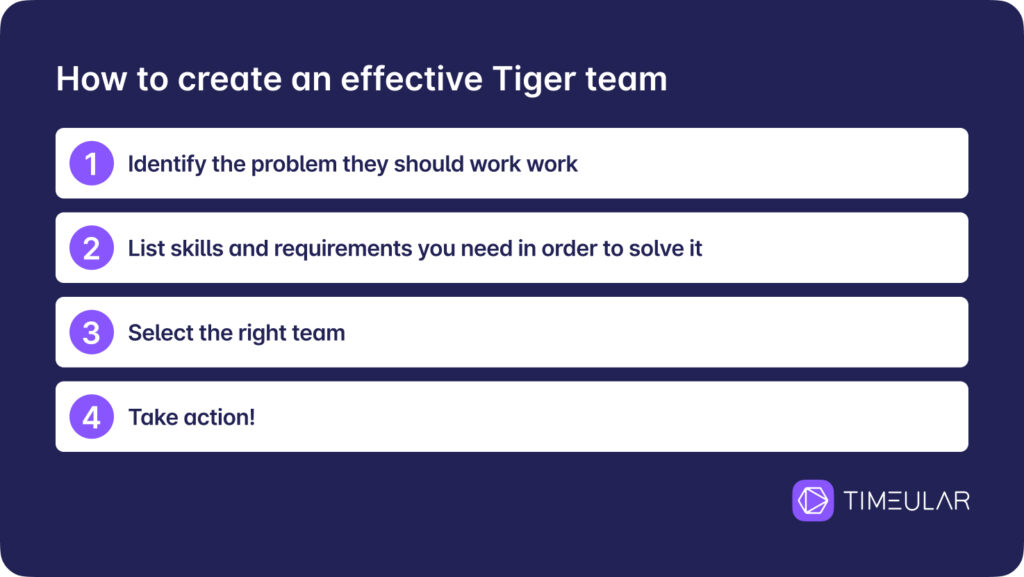Tiger Team förklarat: Vad det är och hur det hjälper till med kritiska frågor
"Houston, vi har ett problem" - astronaut Jim Lovel, 1970.
Det var då Tigerteam-metoden blev populär - med Apollo 13-uppdraget.
När astronauten började få slut på luft under Apollo 13-uppdraget behövde han och hans team snabbt föras tillbaka till jorden.
Det finns gott om dokumentärer som beskriver hur de hämtas tillbaka till jorden, men i den här artikeln får du lära dig mer om kraftpaketet bakom det hela: Tiger-teamet.

Vet du hur lång tid ditt team behöver för att lösa kritiska frågor?
Vad är ett Tiger-team?
Ett Tiger-team är en grupp ämnesexperter med olika bakgrund som bildar ett tvärfunktionellt team. Teamets enda syfte är att lösa ett särskilt problem som är kritiskt och har en hög angelägenhetsgrad.
Detta tvärfunktionella team har som mål att sammanföra flera perspektiv för att lösa dina komplexa frågor snabbt, effektivt och med låg risk.
Även om Tiger Team-konceptet är mest känt för Apollo 13-uppdraget, har det sitt ursprung i den amerikanska flottan på 70-talet. Det som ursprungligen var ett utvalt tekniskt team med uppgift att identifiera sårbarheter i säkerhetssystem växte i popularitet och har antagits inom olika områden och företag.
Än i dag bygger många företag tigerteam, som består av mogna experter med de nödvändiga färdigheterna för att identifiera problem och lösa varje kritisk fråga med innovativa lösningar. Om du har möjlighet att bygga tigerteam i din organisation är du privilegierad, eftersom dessa typer av tvärfunktionella team löser problem med smidighet och lindrar dina brådskande frågor.

När ska man bygga Tiger-team?
Det enklaste svaret är: När du ställs inför kritiska utmaningar med stor inverkan som påverkar din organisations säkerhet, affärsutveckling eller till och med existens, är det obligatoriskt att sätta samman ett Tiger-team.
I en organisation eller ett projekt har ett Tiger-team till uppgift att ta itu med kritiska och avgörande frågor som kan uppstå under projektets gång. Som en grupp experter undersöker tigerteamet noggrant för att upptäcka grundorsaken till problemet. De ger sedan organisationen en strategisk riktning och skisserar möjliga lösningar för att lösa problemet.
För rutinmässiga och okomplicerade problem som har lättillgängliga lösningar finns det ingen anledning att investera i en sådan fokuserad grupp.

Du har två alternativ när det gäller att implementera en Tiger-teamstrategi:
Alternativ A: Skapa ett Tiger-team genom att välja ut teammedlemmar som enbart ägnar sig åt att lösa ett specifikt problem. Under problemlösningsperioden är deras enda fokus att eliminera problemet. När problemet är löst kan de återgå till sina ordinarie arbetsuppgifter.
Alternativ B: Välj ut teammedlemmar som fortsätter med sina ordinarie arbetsuppgifter och arbetar med att lösa problemet. I det här scenariot är det viktigt att använda en prioriteringsteknik för att hantera arbetsbelastningen på ett effektivt sätt.
Vilka ingår i ett Tiger-team?
Sammansättningen av ett Tiger-team avgörs av de specifika behoven och omständigheterna hos ditt företag, dina intressenter och dina projektledare.
Sammansättningen av ett Tiger-team baseras på faktorer som problemets art, de nödvändiga kompetenserna, projektets omfattning och hur brådskande det är att lösa det.
Vanligtvis består ett Tiger-team av en grupp experter med erfarenhet på seniornivå. Medlemmarna i Tiger-teamet kommer från olika avdelningar inom organisationen, bland annat ekonomi, marknadsföring, IT och design, för att säkerställa olika perspektiv.
Nyckeln är att välja teammedlemmar med rätt kompetens och expertis som är skräddarsydda för att lösa den aktuella kritiska frågan. För att fira framgångar är det viktigt att välja de mest kvalificerade experterna med olika färdigheter, vilket säkerställer att teamet är väl rustat för att hantera problemet på ett effektivt sätt.
Målet är att skapa ett väl sammansatt team som kan uppnå en hög framgångsgrad i problemlösningen.

Varför är det bra att bilda ett Tiger-team?
Att gå med i eller bilda ett Tiger-team kan förändra spelplanen för ditt projekt eller din organisation. Dessa dynamiska grupper, som består av experter från olika bakgrunder, ger en mängd fördelar, särskilt när det gäller att ta itu med utmaningar direkt.
Det är dock viktigt att notera att tigerteam inte är en lösning som passar alla. De kräver anpassning till de unika behoven i din situation.
Men även om etablerade rutiner har sina fördelar, kan införandet av ett Tiger-team ge ett nytt perspektiv och en rad oförutsedda fördelar.
Här är en titt på fördelarna med en tigerteamstrategi:
Proaktiv attityd: Att bilda ett tigerteam garanterar att dina problem kommer att hanteras kreativt, smidigt och lösas på nolltid med effektiva lösningar. Tigerteamen består av ohämmade tekniska specialister som utmärker sig genom sin proaktivitet.
Förbättrat samarbete: Dessa tvärfunktionella team tar kommunikationen och samarbetet mellan avdelningarna till nästa nivå, vilket gör det lättare att hitta de bästa lösningarna på komplexa utmaningar.
Förstärkt beslutsfattande: Tigerteamen bidrar med flera olika perspektiv, vilket tvingar fram innovativa och kreativa lösningar i organisationen och bara kan ge dig en fördel jämfört med dina konkurrenter i framtiden.
Mångfacetterade perspektiv: Tiger-teamen arbetar för att undersöka problem från olika vinklar, vilket hjälper dig att få insikter om dina kritiska problem.
Katalysator för innovation: Detta team av specialister kommer att sätta igång nya idéer inom tjänste- eller produktutveckling, befintliga processer som behöver förbättras och mycket annat.
Insikter som är redo för framtiden: De ger värdefulla insikter för framtida tillväxt och positionerar organisationen strategiskt för att hantera potentiella problem på ett effektivt sätt.
Kostnadseffektivitet: Tiger-teamen effektiviserar processer, optimerar resursfördelningen och tar på ett kreativt sätt itu med grundorsaken till dina problem, vilket bidrar till kostnadsminskningar.
Ökad försäljningsprestanda: Den här arbetsgruppen kan indirekt leda till betydande förbättringar av försäljningsresultaten tack vare deras innovativa idéer.

Hur man skapar ett effektivt Tiger-team
Att bygga upp ett effektivt Tiger-team kan verka enkelt, men det handlar om specifika riktlinjer som är viktiga för att bygga upp ett mycket funktionellt och effektivt team.
Även om processen kan vara utmanande är det väl värt ansträngningen med tanke på de fördelar som vi har beskrivit tidigare. Här är de tre viktigaste stegen du behöver följa:
Identifiera problemet
Ett Tiger-team är utformat för att hantera en specifik och kritisk fråga inom ditt projekt. Det första steget, och det viktigaste, är att tydligt definiera det exakta problem som du vill lösa. Det är viktigt att fastställa teamets omfattning och sammanhang.
Det idealiska tillvägagångssättet är att skapa en omfattande briefing som beskriver alla viktiga detaljer som ska kommuniceras till ditt Tiger-team.
Lista färdigheter och krav
När du har identifierat det kritiska problem som kräver uppmärksamhet är det dags att vidta åtgärder. Om du har en tydlig bild av problemet kan du sammanställa en exakt lista över de färdigheter och den expertis som behövs för att lösa det och undvika att omfattningen ökar.
Genom att se till att du samlar in alla nödvändiga uppgifter med precision minimeras felmarginalen när du väljer ut medlemmarna i Tiger-teamet.
Välj rätt team
Det finns ett kort svar på frågan om vem som ska få ingå i den särskilda gruppen: De bästa tvärfunktionella experterna i företaget.
Att bygga upp ett Tiger-team är som att sätta ihop en högpresterande ensemble. Du behöver de allra bästa individerna för jobbet. När du har beskrivit de färdigheter och krav som krävs kan du nu fokusera på att identifiera de kollegor som bäst matchar dessa kriterier.
Ta dig tid att analysera varje teammedlem, genomför intervjuer om det behövs och handplocka dem som är oumbärliga för ditt Tiger-team. Detta selektiva tillvägagångssätt säkerställer att teamet är optimerat för den aktuella uppgiften och maximerar chansen att lyckas.
Läs vårt inlägg och få de bästa tipsen för att förbättra kommunikationen i ditt team

Vad du bör undvika när du leder Tiger-teamets medlemmar
Tigerteam är kända för sina unika fördelar, som ger möjlighet att säkerställa optimala projektresultat. Men trots styrkorna finns det fortfarande en betydande risk att stöta på utmaningar, oavsett om de härrör från interna eller externa faktorer.
Lyckligtvis kan du mildra dessa hinder genom att vara proaktiv och förutse potentiella problem. Här presenterar vi ett urval av vanliga misstag som du bör undvika när du arbetar med Tiger-team:
Avsaknad av strategisk planering
Utan någon planering kommer ditt Tiger-team inte att kunna lösa det problem du har med ditt projekt.
Se till att det finns en tydlig steg-för-steg-strategi för att vägleda teamet genom problemet och de färdigheter som måste elimineras.
Ofullständig genomgång av problemet
Utan en väldefinierad strategi kan ditt Tiger-team få svårt att hantera projektets utmaningar på ett effektivt sätt. Se till att det finns en tydlig steg-för-steg-plan på plats som vägleder teamets åtgärder och ger de nödvändiga färdigheterna för problemlösning.
Distraherad fokusering
Efter att ha tagit itu med den första frågan är det möjligt att hamna i orelaterade diskussioner. För att upprätthålla effektiviteten är det viktigt att hålla teamet fokuserat och engagerat i det slutliga målet.
Försummelse av dokumentation
För varje procedur som ett Tiger-team blir involverat i är det lätt att glömma bort behovet av att dokumentera allt. Under hela resan mot att lösa problemet måste de lämna efter sig dokument och guider som kan hjälpa andra team i framtiden. Det kan vara till stor hjälp vid hanteringen av olika problem längs vägen.

Slutsats
Sammanfattningsvis är tigerteam dynamiska tvärfunktionella grupper av experter som utmärker sig genom att ta itu med kritiska frågor inom projekt och organisationer. De bidrar med en proaktiv attityd, förbättrat samarbete och mångfacetterade perspektiv, vilket driver innovation och kostnadseffektivitet.
För att bygga ett effektivt team krävs noggrann problemidentifiering, krav på kompetens och val av topptalanger samtidigt som man undviker fallgropar som brist på strategisk planering och försummelse av dokumentation.
Att införliva detta tillvägagångssätt i din projektverktygslåda handlar om mer än bara problemlösning. Det är ett strategiskt steg mot att nå framgång trots komplexa utmaningar och främja en kultur av innovation och tillväxt.
Vanliga frågor
Hur stort är ett Tiger-team?
Det finns ingen specifik siffra för att definiera ett Tiger-team. För att vara ett bra team måste det koncentrera sig på det bästa urvalet av medlemmar på senior nivå med en hög uppsättning färdigheter så att alla områden täcks in.
Varför kallas det ett Tiger-lag?
Termen "tigerteam" har sitt ursprung i det militära och blev känd när NASA satte in ett tigerteam under Apollo 13-uppdraget 1970 för att lösa komplexa problem med exceptionell snabbhet och expertis. Det tvärfunktionella teamet av specialister vann till slut en medalj av presidenten för sin framgång.
Vad är ett Tiger-team inom Agile?
Inom Agile-metodiken är ett tigerteam en grupp experter från olika avdelningar som samlas för att lösa kritiska problem eller utmaningar snabbt och utan att leverera den mest sannolika lösningen som du kanske redan har övervägt.